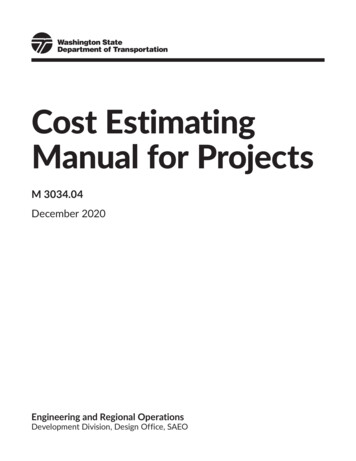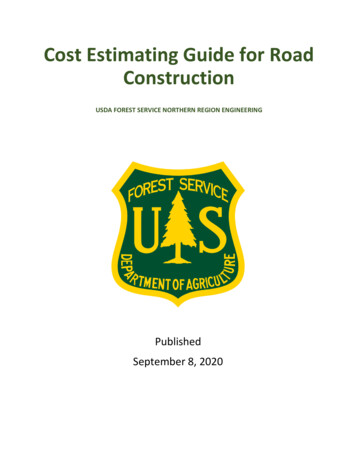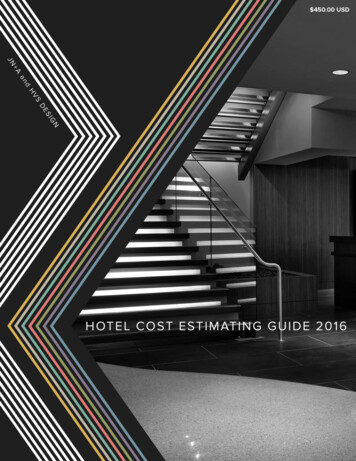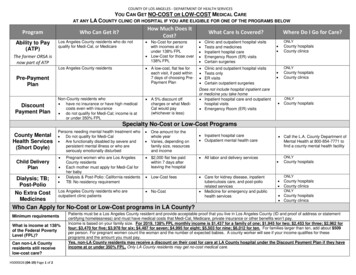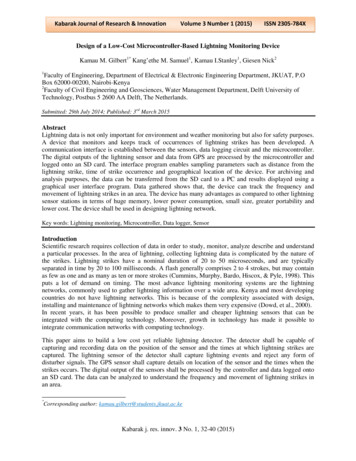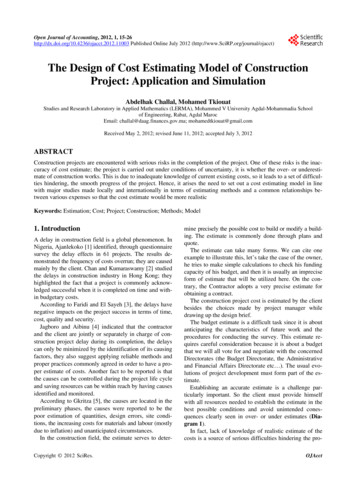
Transcription
Open Journal of Accounting, 2012, 1, 15-26http://dx.doi.org/10.4236/ojacct.2012.11003 Published Online July 2012 (http://www.SciRP.org/journal/ojacct)The Design of Cost Estimating Model of ConstructionProject: Application and SimulationAbdelhak Challal, Mohamed TkiouatStudies and Research Laboratory in Applied Mathematics (LERMA), Mohammed V University Agdal-Mohammadia Schoolof Engineering, Rabat, Agdal MarocEmail: challal@daag.finances.gov.ma; mohamedtkiouat@gmail.comReceived May 2, 2012; revised June 11, 2012; accepted July 3, 2012ABSTRACTConstruction projects are encountered with serious risks in the completion of the project. One of these risks is the inaccuracy of cost estimate; the project is carried out under conditions of uncertainty, it is whether the over- or underestimate of construction works. This is due to inadequate knowledge of current existing costs, so it leads to a set of difficulties hindering, the smooth progress of the project. Hence, it arises the need to set out a cost estimating model in linewith major studies made locally and internationally in terms of estimating methods and a common relationships between various expenses so that the cost estimate would be more realisticKeywords: Estimation; Cost; Project; Construction; Methods; Model1. IntroductionA delay in construction field is a global phenomenon. InNigeria, Ajanlekoko [1] identified, through questionnairesurvey the delay effects in 61 projects. The results demonstrated the frequency of costs overrun; they are causedmainly by the client. Chan and Kumaraswamy [2] studiedthe delays in construction industry in Hong Kong; theyhighlighted the fact that a project is commonly acknowledged successful when it is completed on time and within budgetary costs.According to Faridi and El Sayeh [3], the delays havenegative impacts on the project success in terms of time,cost, quality and security.Jagboro and Aibinu [4] indicated that the contractorand the client are jointly or separately in charge of construction project delay during its completion, the delayscan only be minimized by the identification of its causingfactors, they also suggest applying reliable methods andproper practices commonly agreed in order to have a proper estimate of costs. Another fact to be reported is thatthe causes can be controlled during the project life cycleand saving resources can be within reach by having causesidentified and monitored.According to Gkritza [5], the causes are located in thepreliminary phases, the causes were reported to be thepoor estimation of quantities, design errors, site conditions, the increasing costs for materials and labour (mostlydue to inflation) and unanticipated circumstances.In the construction field, the estimate serves to deterCopyright 2012 SciRes.mine precisely the possible cost to build or modify a building. The estimate is commonly done through plans andquote.The estimate can take many forms. We can cite oneexample to illustrate this, let’s take the case of the owner,he tries to make simple calculations to check his fundingcapacity of his budget, and then it is usually an impreciseform of estimate that will be utilized here. On the contrary, the Contractor adopts a very precise estimate forobtaining a contract.The construction project cost is estimated by the clientbesides the choices made by project manager whiledrawing up the design brief.The budget estimate is a difficult task since it is aboutanticipating the characteristics of future work and theprocedures for conducting the survey. This estimate requires careful consideration because it is about a budgetthat we will all vote for and negotiate with the concernedDirectorates (the Budget Directorate, the Administrativeand Financial Affairs Directorate etc ). The usual evolutions of project development must form part of the estimate.Establishing an accurate estimate is a challenge particularly important. So the client must provide himselfwith all resources needed to establish the estimate in thebest possible conditions and avoid unintended conesquences clearly seen in over- or under estimates (Diagram 1).In fact, lack of knowledge of realistic estimate of thecosts is a source of serious difficulties hindering the proOJAcct
16A. CHALLAL, M. TKIOUATDiagram 1. The causes of Risks of over or under cost estimate.gress of construction project; the estimates made by companies are most of the time established hastily becausethey have to make a big number of offers to make a dealit is worth noting that the multiple number of participating parties in building sector, the new construction technologies and innovations give a room to complexity anduncertainties in establishing estimates for projects.The common practise nowadays in drawing up budgetestimate of construction building project is done by theclient and the company, the process is mainly done onthe basis of two approaches: It is whether according to thecost of m built or on the basis of prices of similar works ofa project.In the first method, the established estimates are notprecise since the buildings found around constructionsites are not identical, consequently, the cost of a squaremeter built is whether over- or underestimated.The use of second method requires the management ofcost per unit; it ought to be inspired continuously by theexperience obtained through recent construction sites.The existence of unrealistic unit costs will not guaranteean accurate estimate of project costs.The aim of this work is designing cost estimationmodel of a construction project. To achieve this aim, thefollowing points are to be applied:First, an analysis of the main existing cost estimatemodels and defining their advantages as well as theirdrawbacks in order to have them compared and focus onthe one that will be used in construction project of theCopyright 2012 SciRes.present work.Second, defining the multiple components of construction project cost, in fact, each price consists of many elements, so before making any calculation of whatever price(purchase price, cost price ), one have to make a list ofthe components of price and then make their estimates.Then emphasis is to be put first on the important estimate phases in construction project and later on commonrelationships, another area to be emphasized here is theimportance of taking charge of the project by softwaremanagement for building a construction cost estimatingmodel that is tested in a real case study.This paper is organized as follows: Section 1 deals withthe previous studies on the causes of overestimate or underestimate of costs in construction projects; Section 2explains the cost estimate models and elementary components to determine the estimate of a construction project. Section 3 discusses the findings and Section 4 presents the conclusions.2. Literature ReviewVarious articles and studies have been conducted internationally on the causes of in construction projects. Kaming et al. [6] studied the causes of over- or underestimate of 31 sky-scrapers costs in Indonesia. She confirmed that the costs overruns often occur and are considered to be more important than deadline slippage; shealso cited the main causes of cost overruns: increase dueOJAcct
A. CHALLAL, M. TKIOUATto inflation, the underestimate of equipment costs and thelevel of complexity of the construction project. The causesrelated to time overruns are: design changes, low productivity, inadequate planning, and resource shortages. AlMomani [7] in his survey on 130 public projects in Jordan pointed out that the main causes of delay are: poorproject design, climate, poor site management, delay indelivery, economic situation and the amendments. Herecommended that managers of public projects take thenecessary time to start carrying out thorough studies byusing real quantitative data in order to formulate pertinent terms before starting to attribute the said project.The study also suggested that special attention be givento industrialists in the field of construction to reduce thepurchasing costs. Consequently, the delays are essentially due to poor contracters’ productivity. Toor and S. O.Ogunlana [8] and Saleh Al Hadi Tumi et al. [9] believedthat poor planning and lack of communication are theprinciple causes of deadline slippage in construction projects in Libya. Ogunlana et al. [10] noticed that time andcost overruns in construction projects of sky-scrappers inBangkok and Thailand resulted from three factors: lackof infrastructure, default in payment by both customersand consultants, and contractors incompetence; they recommended that managers and associations specializingin the field of construction make more efforts to streamline and build the infrastructure which would allow easysupply of materials and boost efficiency in constructionfield.Researchers have examined and identified the causesof cost overruns in construction projects (Table 1) andconfirmed that most causes fall properly to firms by 51%and 30% to the project manager while 90% of these causesare related to the internal organization of involved parties.3. Cost Estimating Methods and theElementary Components to Determine theEstimate of a Construction Project3.1. The Cost Estimating MethodsThe estimates are made by humans and not by tools, thetools are means used by the analysts while reliable expertsystems that can estimate costs are still unfound.All estimates are based on comparisons. They are basedon data base of the company. A handbook on costs thatmay allow the creation of a data base related to its activity still does not exist. In order to estimate, technicalknowledge of context, tools, products, technologies andused means of production must be acquired. There are anumber of estimating methods differentiated mainly bythe level of precision that is desired in the results.This includes: The analytical methodCopyright 2012 SciRes.17 Parametric method Analogy methodA method is not used randomly, there must be a coherence of the information obviously available, it is worthconsidering the progress of the project and what mayrequires the method to start functioning.3.1.1. Analogy Method3.1.1.1 General PrincipleThe analogy method of cost estimating functions bycomparing the proposed project to previously similarcompleted projects where the cost and the functional definition is known.By comparison, a sound judgment must be reachedthrough the characteristics of two completed projects. Thisjudgment must be quantified in a way that can be translated in terms of cost. The method must reduce the maximum of subjectivity.The principle of this method is to implement an extrapolation of similar cases (source case) and of presentcase (target case). The source cases are extracted by thehistorical databases of the project.The structure of the target case can be different fromthe source case. The case basis must be enriched continuously by new treated cases.2.1.1.2 Conclusion on Analogy MethodIt is worth stating its weaknesses since the use of theAnalogy method gives rise to certain concerns.a) It leaves room to subjectivity. Such observation islargely tempered by the fact that we put our trust on adetailed level limited enough in comparison with completion that is finished and known;b) It supposes that the comparisons made are valid,such fact leads.One to seek recent projects due to the need to keeppace with rapidly developing technologies, however, thisis not always attainable on the one hand, on the otherhand, the diversity of projects stands an obstacle to findclose completions to standardized data on the other hand.c) It implies that the development and production logics have to be the same to be able to assess those whichare different; this is a serious obstacle in the measuringwhere an advanced level of estimate is required for thestudy. However, there exist no magic methods that canavoid asking such kind of question!In fact, this method provides in a timely and responsivemanner accurate estimate with low costs if it is rigorouslyapplied. It allows having rapid studies of sensitivity whileworking on coefficients of analogy. It can therefore beused as input for comparison of principles for solutionsstudied in the analysis of value. However, one must notexpect extraordinary precision.OJAcct
A. CHALLAL, M. TKIOUAT18Table 1. Identified deadline slippage causes in construction projects over the last two decades.Author/years/countriesNo.Deadline slippage causes in construction projects1Poor site management2Ineffective planning and scheduling of project by contractorKoushk et al.2005, Kuwait Financial difficulties by contractorShortage of labours5Delay in delivery of materials to site 6Change orders by owners during Construction 7Lack of materials 8Lack of communication between the parties9Lack of consultant’s experience10Inaccurate estimates11Bad weather12Incompetent subcontractor13Mistakes during constructionImproper construction method used by subcontractors15Delay payments by the client16Low productivity level of labors17Problems with subcontractors18Equipment unavailability19Problem with neighbors and site condition20The bidding process and award 3414Zaneldin, 2006,Faridi and El-Sayegh, 2006,United Arab EmiratesUnited Arab Emirates 21Poor contract management by consultant22External constraints from government23Slowness in decision making process by client24Mistakes and discrepancies in design documents25Late in reviewing and approving design documents by consultant 26Delays in producing design documents 27Inadequate contractor experience3.1.2. Parametric Method3.1.2.1. General Principle and Classification ofParametric MethodsThe cost estimating model used in design phase must be incoherence with the definition report of the project. It isthen better to consider the concept of product architecture.We have not known yet how these products will be produced, but we can access a number of physical characteristics or parameters like the mass, the volume, the e
Estimate of a Construction Project. 3.1. The Cost Estimating Methods . The estimates are made by humans and not by tools, the tools are means used by the analysts while reliable expert systems that can estimate costs are still unfound. All estimates are based on comparisons. They are based on data base of the company. A handbook on costs thatFile Size: 753KBPage Count: 12
